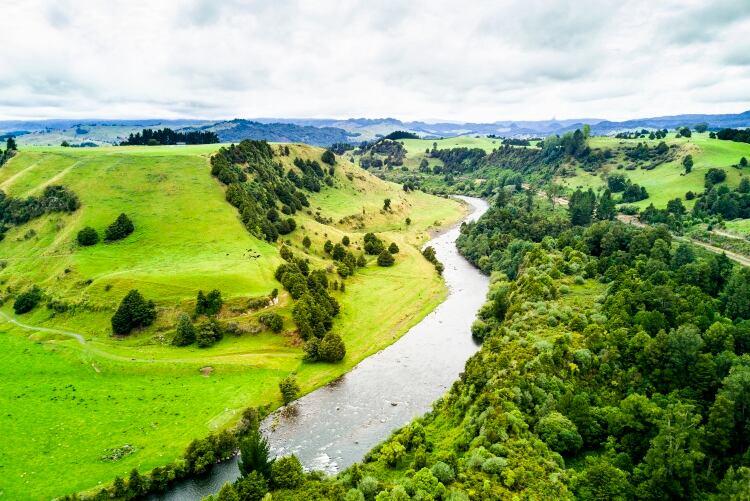The museum, Te Papa, said the Te Taiao Nature exhibition that displayed the water bottle had been designed to take look at New Zealand’s environment broadly, including the threats it faces and what can be done to protect it.
But Tim Mackle, chief executive of industry group DairyNZ, last month accused it of “reinforcing an overly simplistic, anti-farming narrative” that tarnishes the public perception of New Zealand’s dairy sector.
“The water in their display is not reflective of what your average farm stream in NZ would look like.”
Soon after, it became a political issue when National party agriculture spokesman Todd Muller tweeted a photo captioned “Te Papa water quality display presents this as water from a typical farm stream. What do you think? Any farmers want to post a bottle of water from their farm streams to compare?”
In a later tweet, the MP pointed out that dairy farmers had fenced off most of the waterways crossing their land and “the image of a cow standing in water defecating is… not reflective” of this.
“It's imagery like this that reinforces an overly simplistic anti-dairy narrative. Put yourselves in the shoes of our farmers who have invested thousands of dollars on fences and planting to improve environmental outcomes,” Muller added in another.
Te Papa responded by backing down and relabeling the water, which it earlier indicated had come from the Waikato farming region of North Island. The new bottle showed the cow standing on solid ground and no longer defecating. The liquid had been revealed as brown dye, not water from an actual stream.
Te Papa chairwoman Dame Fran Wilde won little sympathy from farmers by not apologizing for the exhibit. Instead, she called the incident a “huge misunderstanding.”
“We realize now that when we have a display like this, people are going to see things that we didn't intend them to see.
"We should have thought through how that might be perceived but we've done that now and we've changed it,” she added.
Water concerns
Waterways are a touchy subject in New Zealand, where the dairy industry is the single biggest user of irrigated water, accounting for about 44% of all consumption.
Farmers have been accused of allowing their cattle to pollute rivers and streams with effluent, causing billions of dollars of damage.
Some cow effluent is captured in the soil but not all of it, and the remainder ends up in aquifers or rivers and lakes, say the critics. The problem is worse if the soils are porous, such as in Canterbury.
According to a poll by Fish and Game New Zealand published last year, river and lake pollution is worrying New Zealanders more than any other issue.
“Kiwis are extremely worried that they are losing their ability to swim, fish and gather food from their rivers, lakes and streams,” said chief executive Martin Taylor. It must be noted, though, that the authority and the dairy industry have a history of being at loggerheads.
The Labour coalition government has pledged to make the country’s rivers and lakes swimmable within a generation. This is a more ambitious goal than that of the previous National government, which promised only to make them “wadeable”.
Dairy initiatives
The dairy industry has countered the attacks by stressing how it has been addressing the issue through a range of initiatives such as fencing off waterways, planting banks and restoring wetland areas.
Farmers have also installed sophisticated on-farm effluent management systems, and many have retired sensitive areas of their land, DairyNZ’s Muller wrote in an editorial last year.
“In recent years, dairy farmers have collectively undertaken what I believe to be one of the biggest, if not the biggest, voluntary conservation initiatives this country has ever seen.
“The simple reality these days is that no dairy cow can get into a stream thanks to dairy farmers [fencing off] significant waterways on farms,” he added.
Under New Zealand’s Sustainable Dairy Water Accord, a set of national good management practice benchmarks aimed at lifting environmental performance on dairy farms, the industry has achieved some impressive results.
Now it can boast that 98.3% of waterways had been fenced by dairy farms to keep cattle out, all stock crossing points have bridges and culverts and every farm has been assessed for effluent management practices.
Back to the Te Papa row, the museum’s spokesperson, Kate Camp, last week told Dairy News the exhibition’s water content was based on various science and research papers including an authoritative report on New Zealand’s freshwater composition, though no groups or individuals had been consulted.
She said Te Papa’s challenge had been to take a complex picture and present it in a simple way so is still true to the overall picture.
“We can’t be an encyclopaedia that presents the full complexity of an issue, but we can spark interest and get people thinking and talking.
“Te Papa is a place for New Zealanders to have important and sometimes difficult conversations—that’s something we don’t shy away from,” Camp said.
The museum acknowledges that there are many farmers and organizations who are caring for New Zealand’s waterways, and appreciate the work rural communities are doing.
“We had never suggested that these are samples of actual water, and have added a note to the display to make it clear that these bottles are not samples but are only symbolic,” Camp said.
The defecating cows have now been changed, she confirmed.
“It now shows a cow standing on a solid background, with wavy lines nearby which symbolizes that farm run-off is reaching many waterways, without giving the impression that cows are pooing directly into streams.”

